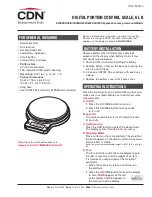
38
Immediate and Continuous Print Modes
Two types of output modes are available on Setra scales - immediate and continuous
print modes.
The immediate print mode is enabled by transmitting a "P" over the RS-232 or by
pressing
on the keypad when "string format" is selected. In this mode, the
contents of the display are transmitted. The print command may follow another
command or series of commands. For example, if ".TP" was transmitted; or the
sequence,
./rcl
,
tare
,
was pressed, the scale would send the contents of the tare
register. Using this mode, a computer can read data from the scale only when
specifically requested.
If the scale is not in "string format" the immediate print mode can be activated only
from a computer. This is done by transmitting the "#" symbol. Within one second of
receiving the "#" command the scale will transmit all displayed information, as well as
information stored in the ID registers.
For continuous data output, use the continuous print mode to print the contents of the
display every time a new reading or message is available. The rate at which data is
updated is programmable from once every .2 seconds on up. This mode is useful if
the computer/scale software interface can run as a background process. For ex-
ample, on a personal computer, a machine language routine can be written to input
data from the scale and place it in a memory location. This memory location can be
accessed by a BASIC program only when the data is required.
The continuous data mode is initiated by sending ".2P" over the RS-232, or by
pressing
./rcl
,
2
then
on the keyboard. This mode is cancelled by sending "— P"
or pressing
—
then
on the scale’s keypad. Values greater than .2 can be used
for longer intervals between data transmittals.
In the continuous print mode, any messages that appear in the display, including
error messages such as "UnAbLE", will be transmitted over the RS-232.
The continuous print mode always transmits "string format," regardless of which print
format is selected.
Note:
When using the continuous print mode, it is recommended that the baud rate
be set at 2400 or higher to ensure that the all scale output can be transmitted.
If the baud rate is set too low, the internal output buffer in the scale may
overflow, causing a “Q-out oflo” error message to be transmitted. Conversely,
if commands are sent too fast, the scale will not process them which will cause
a “Q-in oflo” error. However, since the scale can buffer 256 input characters,
the probability of encountering this error is small.










































